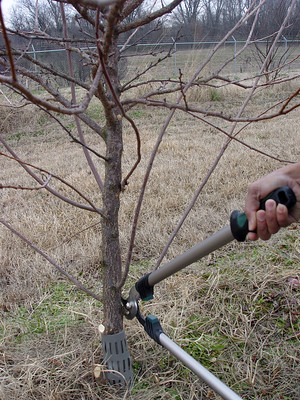Pruning Fruit Trees
When do you prune fruit trees?

Nashville, Ark. –
One of the most common questions asked this time of year is, “Is it too early to prune my fruit trees?” The answer is NO. Late winter early spring is the ideal time to begin pruning just before active growth. Many of you may wonder why, what, where, and how do we prune our trees correctly without causing stress or damage. Each year we spend a lot of time, money, and energy pruning. Why do we do this?
- To maximize fruit growth and quality we must prune.
- To make sure our tree is not overpopulated with small, bad fruit we must prune.
- To increase flower production
- To make it easier on the producer when it is time to harvest the fruit. A little work on the front end goes a long way.
- Also, to increase the movement of air flow; to reduce disease incidence.
What and where do you prune fruit trees?
Knowing the “what” and “where” when deciding which branches, canes, and stems to remove plays an important role in the growth stage of the tree. A tree that has been pruned and trained properly from the beginning will have a strong central leader or open center with larger yields and better quality. Apple, apricot, cherry, pear, and plum trees are generally pruned to the central leader method, meaning the growth pattern of these trees is for the main stem of the tree to be dominant. Peach and nectarine are typically pruned as open center (a method that has a strong tendency for one shoot or branch to dominate the growth of other shoots or branches) but can be pruned as central leaders as well.
How do you prune fruit trees?
Finally understanding the “how” part of pruning. What kind of cut are you going to make when removing a shoot or branch? If you are heading back, then you are removing a part of a shoot or a branch at the terminal buds. This will have major effects on the Apical dominance causing much stress or possible loss. Result of this cut is to increase total shoot growth.
Maybe you choose the thinning method; then you are removing the entire shoot or branch at its junction with the trunk. This allows the ratio of terminal to lateral buds that are disturbed to be the same. There will not be a large increase in shoot growth due to thinning.
For more information, you can send an email to shorn@uada.edu. Howard County Extension office is still working and is there for all the residences in Howard County during this time.
By Samantha Horn
County Extension Agent - Agriculture
The Cooperative Extension Service
U of A System Division of Agriculture
Media Contact: Samantha Horn
County Extension Agent - Agriculture
U of A Division of Agriculture
Cooperative Extension Service
421 N. Main Nashville AR 71852
(870) 845-7517
shorn@uada.edu
The Arkansas Cooperative Extension Service is an equal opportunity institution. If
you require a reasonable accommodation to participate or need materials in another
format, please contact your County Extension office (or other appropriate office)
as soon as possible. Dial 711 for Arkansas Relay.
Pursuant to 7 CFR § 15.3, the University of Arkansas System Division of Agriculture
offers all its Extension and Research programs and services (including employment)
without regard to race, color, sex, national origin, religion, age, disability, marital
or veteran status, genetic information, sexual preference, pregnancy or any other
legally protected status, and is an equal opportunity institution.